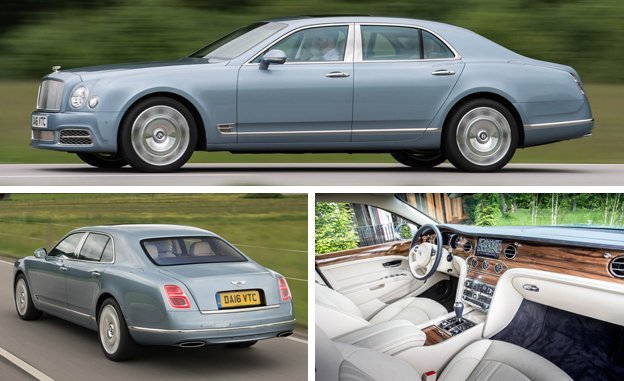If you’re rich—really rich—what fills your heart with dread? Not being rich anymore. Which may explain why the ultra-wealthy are drawn to objects that suggest permanence: big, imposing houses that look like they’ve been around forever and big, imposing cars like the Bentley Mulsanne, which is a veritable manor house on wheels.
That the Bentley hails from the U.K. and carries with it a whiff of British aristocracy doesn’t hurt. The British upper class may be a shadow of what it once was, but its multigenerational high-rollin’ momentum holds a deep-seated appeal to people who fear becoming regular schmoes.
Regular schmoes do not wheel around in Bentley Mulsannes. The least expensive version starts at $310,395, and it can easily top $400,000 with extras. The Mulsanne buyer’s average net worth is $3.4 million—as opposed to only $1.8 million for the piker who might spring for a Flying Spur. More than even that car, the Mulsanne’s solidity, heft, and presence convey a sense of permanence, and it still does despite some changes for 2017.
Luxury, Writ Longer
The big news—literally—is the addition of the Mulsanne Extended Wheelbase, just 25 of which are headed stateside for 2017. We only rode in that model, as will most of its owners. Owing to a 9.8-inch-longer wheelbase and first-class airline-style seats boasting extendable leg rests, the rear compartment is even more luxurious; it also features tables that deploy from the full-length console, power-operated blackout curtains, and an optional refrigerator with holders for the de rigueur crystal champagne flutes.
Besides the Extended Wheelbase model, the lineup also includes the standard Mulsanne and the Mulsanne Speed. The Speed joined the lineup as a 2015 model, while the regular Mulsanne was introduced for 2010. Most vehicles would be undergoing a full redesign after seven model years, but time moves more slowly for the automobile world’s British aristocrats. For 2017, then, the Mulsanne is getting a restyled nose and tail, interior updates, and some chassis tweaks.
The facelift brings a new hood and front fenders. The wider grille now has vertical bars in addition to the previous mesh texture. It’s flanked by new full-LED headlamps with an adaptive beam pattern, sitting above a redesigned lower fascia. The rear bumper also is reshaped, and the taillamps feature a “B” graphic that’s repeated in the front-fender vents.
Have a Cigar
Grab hold of the solid metal handle, open the heavy door, and you’ll find an interior that’s largely familiar. There’s leather everywhere (including on the ceiling and the pillars). A meaty swath of high-gloss wood caps the door panels, matching veneers adorn the dash and console, and the seatbacks feature folding tables. The seats themselves are of a new design; they proved comfortable for a multi-hour sit. For the rear-seat passengers, there are 10.2-inch tablets that rise out of the front seatbacks and can be removed or used in place (in the Extended Wheelbase, they’re rather far away, so a separate remote touchpad is provided). The tablets can control various functions in the car and run a slew of apps via a Wi-Fi hotspot. Up front, the center multifunction display is larger, with reworked logic, Apple CarPlay functionality, and fresh graphics; it’s now a touchscreen, but it retains the same, now more redundant buttons and knob controller. These are still located on the dash rather than in the more typical location on the console ahead of the center armrest. Although the screen is larger, at eight inches, it looks puny in comparison to the wide-screen units in the Mercedes-Benz S-class or the BMW 7-series, let alone the giant screen that dominates the dashboard of the Tesla Model S. Unlike those cars, however, the Mulsanne comes with not one but three hefty chromed-metal ashtrays—it’s almost enough to make you want to take up smoking, although it’d be a crime to stink up this interior.
Like the cabin, the driving experience is familiar. The 6.8-liter turbocharged V-8 dates back 60 years and holds the dubious title of being the only imported engine with a pushrod valvetrain; it was last revised for 2015 (with the arrival of the Speed), and its 505 horsepower and 752 lb-ft of torque are sent to the rear wheels via an eight-speed automatic. Throttle tip-in is extraordinarily smooth, enhancing the sense of effortless acceleration around town. The Mulsanne is a wide machine, a quality you’re much more keenly aware of when driving the car in Europe—as we did—than you might be on broad American boulevards. And yet, exact placement of the Mulsanne on narrow lanes in the face of oncoming traffic is a far less nerve-wracking task than you’d expect, thanks to the hydraulically assisted power steering’s precision and heft.
We also drove the Mulsanne on a stretch of unrestricted autobahn, where one can pin the long-travel throttle all the way into the wool carpet and drink deeply from the V-8’s vast well of power. It’s particularly impressive to be cruising along at a casual 95 mph and just roll into the throttle, feeling the engine’s great wave of thrust push you up to 140 mph—no downshift necessary. With the engine’s torque peak at 1750 rpm and the redline at a diesel-like 4500 rpm, there’s not much point in revving.
Nor is there a whole lot of need for the Speed’s additional 25 horsepower and 59 lb-ft of torque (which cost some $30,000 more). The Speed also comes with dark-tinted chrome exterior trim, diamond-quilted upholstery, 21-inch wheels, and chassis tuning that is ever so slightly firmer. Plenty of buyers choose it, though, if only because it’s the top of the range (or was, before the Extended Wheelbase was added).
For 2017, all Mulsannes are treated to chassis changes that include revised air springs, new bushings, and variable engine mounts—all in the quest of greater refinement. New Dunlop tires are lined with a layer of absorption foam. At highway speeds, tire noise is eerily absent, although wind noise remains. On two-lane roads, the only indication that you’re moving is the passing scenery, and bumps are more rumored than felt.
Imperious, Not Autonomous
The latest electronic driver aids—most of which one can now get in a humble Hyundai or a lowly Chevrolet—are glaringly absent here. There’s adaptive cruise control but no forward-collision warning and no automated emergency braking. Blind-spot warning has been added for 2017, but there’s no cross-traffic alert. Forward-looking and rearview cameras are standard, but there’s no 360-degree view or lane-departure warning. There’s not even lane-keeping assist to allow for even brief moments of hands-free motoring.
So, the Mulsanne is no Tesla. In the realm of ultra-luxury sedans, in fact, it may be the anti-Tesla. (With an EPA combined rating of 13 mpg, it certainly is from an environmental standpoint.) Although Bentley has integrated some new technology, the Mulsanne remains resolutely analog. Comfortably steeped in tradition, it delivers luxury cues that endure—just as its owners hope their fortunes will.
Powered by WPeMatico







